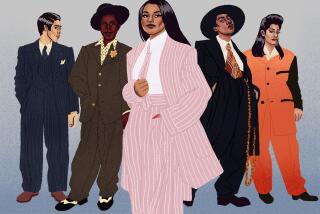Definitive : A Formal Introduction to the Tuxedo
- Share via
Purely American, the tuxedo was born in the 1880s when a wealthy New York social climber, tired of wearing the formal jacket with tails at events, had his tailor make one based on the design of a tail-less English riding jacket.
First worn at parties at his house in Tuxedo Park, N.Y., the popularity of the jacket spread across the country and eventually across the Atlantic.
Tuxedo jackets can be single- or double-breasted with a shawl or notched collar, usually of satin. They can be short, suit length or with long back tails. The pants are always tailored (no cuffs); vests are optional.
While the tux has its roots in the United States, one of its biggest adornments came from India.
The cummerbund is a derivative of the Hindu word kamarband, meaning “loin band.” People from India often wore a kamarband for formal occasions, with the band positioned at just the right point to protect their modesty. The British colonialists took to the idea and began wearing the thick silk band up around their waists.
Today, the wide sash of fabric is worn just high enough to cover the waistband of the tuxedo slacks, the folds facing up. Its design matches the bow tie, and it is usually bought or rented in classic black. However, one can try interesting colors or designs such as cummerbund/tie sets in paisley, metallics or hand-painted silk.
In some warehouse, there must be millions of powder blue and bright red cummerbunds that coordinated with jackets of the same color from the ‘70s. The hot colors today include cream and forest green.
One of the biggest mistakes men make when getting ready for a party is pulling the cummerbund up so high that passers-by can see the white of their shirts at the bottom of the band. Keep it low, and adjust the buckle so that it stays in place (without cutting off circulation through the torso).
More to Read
Sign up for Essential California
The most important California stories and recommendations in your inbox every morning.
You may occasionally receive promotional content from the Los Angeles Times.









